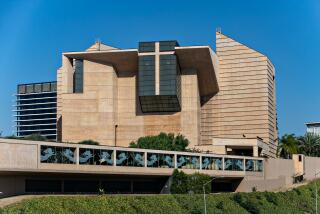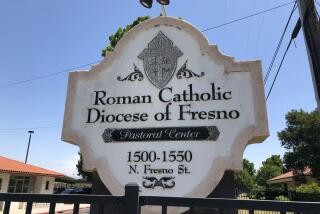After sexually abusing children for decades, Catholic brother lives under the radar in Hawaii
Reporting from SEATTLE — When the Archdiocese of Seattle recently released the names of 77 priests, brothers, deacons and a nun reported to have sexually abused children over an 85-year-period, the list included a short entry near the bottom:
“Courtney, Edward CFC, Unknown,” with the names of three schools.
What readers learned was that Courtney had been a member of the Congregation of Christian Brothers (the Latin version of the name is abbreviated as CFC), and once taught at the three schools.
That was about it.
Though Roman Catholic Church investigators had spent 1,000 hours compiling the offender list and were aided by a former FBI agent, they were unable to determine Courtney’s whereabouts, or even whether he was dead or alive.
But Courtney, who would now be 81, hasn’t exactly disappeared. He sold his Seattle-area home in 2013 and signed a sales document notarized in Honolulu. His phone number and address are listed in the Honolulu phone book.
At the number this week, a recorded voice of an older man told callers to leave a message. Requests for comment left by The Times drew no response. An operator who intercepted messages the next day said the customer was no longer accepting calls.
Also missing from the nine-page Seattle disclosure list was any mention of what Courtney and the 76 others were accused of doing to earn their sex-offender status.
In Courtney’s case, that was a significant omission.
According to court records, the Catholic schoolteacher was a cross-country serial molester, accused of abusing at least 50 children and teens from New York to Chicago and Seattle over three decades.
Among the thousands of church sex-abuse cases in the country, Courtney’s three-decade, coast-to-coast saga stands out in time and distance.
But like many caught up in the historic scandal, Courtney was never prosecuted and didn’t spend a day in jail.
“The name Ed Courtney means nothing when it’s buried in this list,” says Michael Pfau, a Seattle attorney who has sued the church, the congregation and Courtney. His firm settled more than 60 claims for $25 million against priests and brothers overseen by the Seattle Archdiocese and the Christian Brothers.
In a 2013 federal bankruptcy agreement with the congregation, 52 of 400 U.S. claimants named Courtney as their abuser, Pfau said.
Court records revealed a pattern of allegations that were kept quiet in exchange for moving Courtney to another locale — a method the church used to protect priests.
Problems with Courtney surfaced nearly immediately, with his first permanent assignment in 1960 at New York City’s Sacred Heart School. Christian Brothers records say he began to prey on grade school students and was quickly transferred to Brother Rice High School in Chicago, where more problems soon arose.
Still, he remained there eight years until moving to St. Laurence High School in Burbank, Ill., where he was also accused of sexual abuse. The accusations continued after his transfer in 1968 to Brother Rice High in Birmingham, Mich., where he had been named dean of students. Two years later, he was sent to St. Leo High in Chicago, where — following more abuse allegations — he was transferred back to St. Laurence.
NEWSLETTER: Get the day’s top headlines from Times Editor Davan Maharaj >>
The Christian Brothers’ Provincial Council eventually sent Courtney to counseling, but never publicly reported that he’d been accused of molesting students at five schools. After returning to teaching at St. Laurence, he was asked to leave following an allegation involving a freshman boy. He wound up at O’Dea High School in Seattle, records show.
In a 1997 court deposition, Courtney said he was told O’Dea would be his “final trial.”
Christian Brothers alerted the Seattle Archdiocese to Courtney’s history, and O’Dea assigned him to office duties, separating him from the all-male student body.
Two months later, though, he was coaching intramural basketball at O’Dea and the complaints started again. On one occasion, records say, he was seen carrying a youth into a private residence used by the brothers.
One of attorney Pfau’s clients, known as J.B., said that while he was a student at O’Dea, he told the principal that Courtney was molesting him, but was told that Courtney was “just really friendly.” J.B. said the assaults continued and that when he refused to go to a Saturday detention class overseen by Courtney, he was expelled.
The complaints continued into the next school year, when, according to another of Pfau’s lawsuits, a student was attacked by Courtney in a locked classroom. The boy’s father later confronted school officials, who asked Courtney to make a public apology.
Courtney chose not to and was sent to a retreat in Canada for sexual deviancy treatment, according to a Christian Brothers newsletter. “We hope to see him back ‘home’ again in good condition to face the next scholastic year,” the newsletter added.
But when Courtney returned to O’Dea that fall, abuse reports surfaced again. He was moved to a Catholic elementary school and then to a Seattle parish school, St. Alphonsus, where he was named principal. But it wasn’t long before students began to complain, including two brothers who said Courtney had groped them.
Courtney admitted to the youths’ charges and agreed to resign. When he later changed his mind, a school official advised him in a letter that in resigning, he would “save face and leave the area with the respect and admiration of the majority of the St. Alphonsus School people.”
So Courtney quietly left the church school system. But since neither the Christian Brothers nor the archdiocese had reported his abuses to the state superintendent of public instruction’s office, as required, Courtney was able to obtain credentials and took teaching and coaching assignments at public schools in Seattle, Tacoma and central Washington.
When new molestation accusations surfaced, Courtney disappeared. Three years later, he was arrested in Nevada and returned to Othello, Wash. Without a full accounting of past molestation accusations, he was allowed to plead guilty to a single count of indecent liberties. He was given 24 months, suspended, and had to register as a sex offender for one year.
At age 55, apparently, Courtney finally retired from teaching.
In a 2009 deposition, Courtney, then 73, denied he had committed any serious offenses.
“I was not — I don’t know how to say this — very sexually aware at that time,” he said.
His former attorney, John Bergmann, said that his client had expressed regret for his behavior.
When the list of priests, religious brothers, deacons and a single nun was released, advocates who had pushed for better transparency said the tally of alleged molesters and abusers was incomplete and fell far short of what the archdiocese had promised.
The list is “a start,” said Pfau, “but it is long overdue and far from complete.”
Mary Dispenza, Seattle director of the Survivors Network of Those Abused by Priests, or SNAP, agrees. Her group discovered two Christian Brothers and two priests who were left off the list, she says, including one who was accused of fathering two children while on assignment in Alaska. Two other names turned up in media reports.
SNAP says only three of the 77 have ever been convicted of a crime. Brother Courtney was one of them.
Anderson is a special correspondent.
Join the conversation on Facebook >>
ALSO
Who is the gun-toting, brash-talking Nevada lawmaker who helped end the Oregon standoff?
Nevada will be a crucial test for the Clinton and Sanders campaigns
Carlos Santana, Zoe Saldana and other Latinos say Rubio and Bush belong to the ‘party of Trump’
More to Read
Sign up for Essential California
The most important California stories and recommendations in your inbox every morning.
You may occasionally receive promotional content from the Los Angeles Times.










